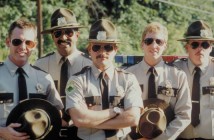
Editor’s Notes: The 33, Labyrinth of Lies, 99 Homes, & Beachhead will be released on their respective formats on February 16th.
The 33

The 33 (Warner Home Video) is based on the 2010 catastrophic explosion and collapse of the 100-year-old San Jose Mine in Chile where 33 miners were buried alive. Over the next 69 days, an international team worked night and day in a desperate attempt to rescue the trapped men as their families and friends, and people around the world, waited and watched anxiously for signs of hope. Meanwhile, 200 stories beneath the surface, in suffocating heat, tensions were rising, provisions dwindling, and time running out. The film switches between the miners’ plight and above-ground attempts to rescue them as director Patricia Riggen takes us through the technical business of drilling down.
The first rule of disaster movies is to provide knowledge about the main characters. With 33 men, that’s hard to accomplish. Director Riggen focuses instead on a few: a veteran miner on the verge of retirement (Gustavo Angarita), a young father-to-be (Mario Cassas), a philanderer (Oscar Nunez), a voice of reason that no one listens to (Lou Diamond Phillips), a drug addict (Juan Pablo Raba), and a Bolivian who ignites tension among the ranks. When conditions worsen, the men look to “Super Mario” (Antonio Banderas), who becomes the unofficial leader, encouraging them to persevere through starvation and lack of oxygen, and serving as referee when in-fighting occurs.
A problem with a movie based on actual events is that the outcome is known. The director must nonetheless sustain attention and build a certain level of suspense. Ron Howard did this in Apollo 13, but The 33 seems more content to draw upon disaster flick cliches and character types. The mostly unknown actors contribute believability to their portrayals, and the means of the men’s survival are recounted in meticulous detail, but the end result never really catches dramatic fire.
Bonus extras on the Blu-ray release include a behind-the-scenes look at creating the mine collapse with the cast, crew, and stunt department; an examination of how this story captivated TV viewers with news footage from around the world; interviews; deleted footage; and theatrical trailer.
Labyrinth of Lies

Labyrinth of Lies (Sony Pictures Classics) is set in Germany in 1958. Attorney Johann Radmann (Alexander Fehling) takes the case of a Jew who recognized one of his former concentration camp guards on the street. None of the other prosecutors will touch the case. Germany and its populace were eager to put World War II behind them. Many Germans could plausibly claim ignorance to both war crimes and national culpability. Radmann’s investigation would only reopen old wounds. Against the wishes of his immediate superior, he begins to examine the case, but soon encounters a web of repression and denial. He devotes himself to his new task, overstepping boundaries, falling out with friends and colleagues, and being drawn deeper and deeper into a myriad of lies and guilt in search for the truth.
As he interviews survivors of the Holocaust, he begins to focus on Auschwitz, and in particular Dr. Josef Mengele, who conducted torture “experiments” on women and children at the camp. But Nazis like Mengele are well-protected in powerful circles.
As we watch events unfold through the eyes of Radmann, the horrors of crimes committed against innocent civilians overwhelm him and he becomes obsessed with seeing Nazis hiding everywhere. This seems a contrivance in an otherwise exceptional film. Perhaps director Giulio Ricciarelli was attempting to show how the extent of inhumanity was too devastating to grasp.
The movie is set between the end of World War II and the 1960 capture and eventual trial of former Nazi SS officer Adolf Eichmann. It reflects a time when not only Germans, but survivors of the camps wanted to move on with their lives and forget the nightmare to which they had been subjected. Radmann’s unpopular efforts and resolve to get to the truth brought to light heinous war crimes.
Special features on the Blu-ray release include commentary with director Giulio Ricciarelli and actor Alexander Fehling; Q & A at the LA Jewish Film Festival with Ricciarelli and Fehling; and deleted scenes.
99 Homes

99 Homes (Broadgreen) is set in Orlando, Florida, at the height of the 2010 foreclosure crisis. Dennis Nash (Andrew Garfield) is a construction worker and single parent forced to move into a motel after he, his child, and his mother are forced to leave their home. The only work Nash is able to find is as a day laborer for Rick Carver (Michael Shannon), the real estate broker who evicted him in the first place. Carver sees potential in the desperate young father and invites him to take a greater role in his business. Though the offer provides security for his family, Nash soon finds his situation growing more brutal and dangerous than he ever imagined.
Shannon is an actor who can convey menace with just a glance, and that ability works well for him as the ruthless Carver, who’s direct, resistant to emotion, and cold as ice as he goes from one foreclosure to another with little concern for the human beings he is leaving homeless.
The film creates enormous tension because its plot is a variation on the deal-with-the-devil. Nash detests Carver, yet looks to him as the only source of income. He must work for him. The survival of his family depends on it. Nash is a man of principle, but his principles erode as opportunity for more money increases. Garfield, best known for his reboot of Spider-Man, exercises his acting chops considerably, conveying a decent guy’s dilemma and its imperfect solution.
Special features on the Blu-ray release include feature-length audio commentary by writer/director Ramin Bahrani and a deleted scene.
Beachhead

Beachhead (Kino Lorber) stars Tony Curtis (Some Like It Hot) as Burke, a World War II Marine who must battle Japanese soldiers, private demons, and fellow Marines. In the Philippines, four Marines embark on a hazardous island mission to verify reports about a secret Japanese minefield. The intelligence comes from a French planter (Eduard Franz, Hatari!), who may or may not be an Allied spy, and his beautiful daughter (Mary Murphy, The Wild One). If their story is true, it’s up to the Marines to outgun their enemies, make it through the treacherous jungle, and rendezvous with American forces in time to prevent disaster. Also starring are Frank Lovejoy (The Hitch-Hiker) and Skip Homeier (The Gunfighter).
The film was made in 1954, at the height of Tony Curtis’ popularity. He was very prolific on screen in the 1950s, having made 32 films during the decade, including Sweet Smell of Success and The Defiant Ones. Though Beachhead doesn’t rank with those two pictures, it is a solid wartime action flick. Curtis does his best to convey a tortured soul but is at his best as an action hero. The obligatory “romantic interest” finds both Curtis and Lovejoy attracted to Murphy, but it is unnecessary and slows the film’s pace. Shot in Technicolor, the movie was filmed in Hawaii.
There are no bonus features on the Blu-ray release.



